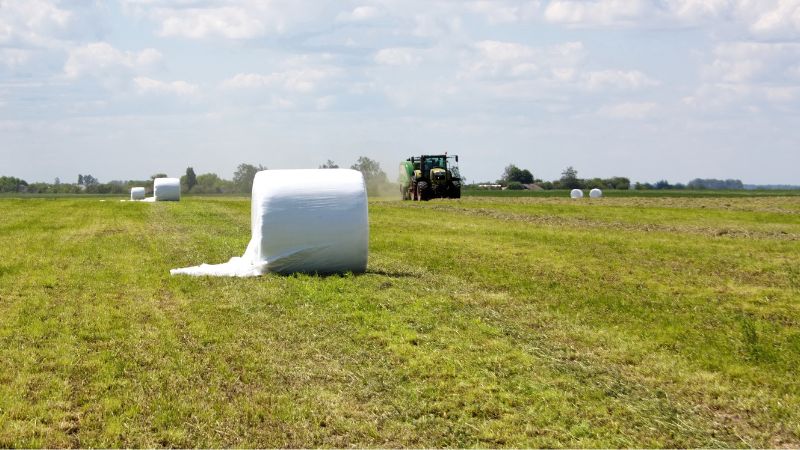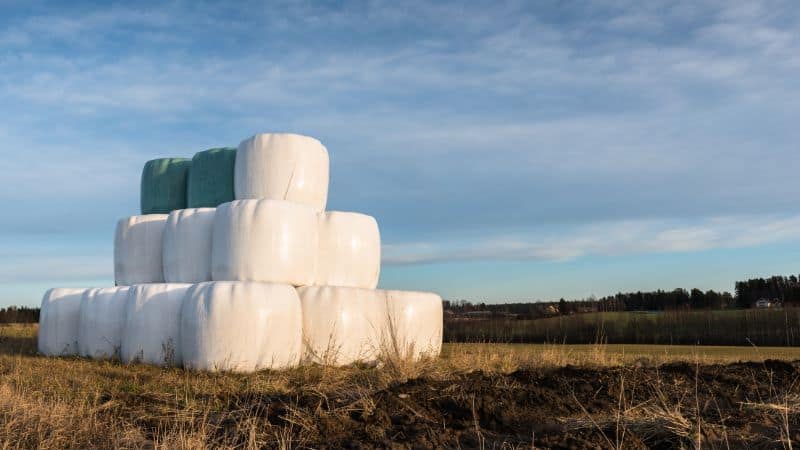Silage film is a great way to keep your silage dry and in good condition, but it can be hard to use properly. This is because of the high winds that are common during the summer months in northern climates, which can cause the film to stretch out of shape if not taken care of properly.
The best way to prevent this from happening is by using a tractor, weight on top of your film, and proper stretching techniques when laying down your film.
What is Silage Film?
Silage film is an agricultural silage wrap used to preserve and store forage crops. Silage films are made of durable, high-quality material that can withstand heavy use without losing integrity, so they’re ideal for long-term storage in commercial facilities or on farms.
The film is made of five layers of a unique MV LDPE. It is polymers that make up the silage film (EVA and EBA). The technique offers outstanding moisture control, incredible damage resistance, and exceptional tear, puncture, and abrasion resistance.
1. Choose the Quality of Film to be Used
The first thing you should do when choosing your silage film is to choose a quality product. There are great differences in the stretchability between the products of different companies, so it’s important to choose one that will fit your needs.
For example, if you want something thin and flexible, then maybe it isn’t worth spending too much money on this type of material. On the other hand if you need something thick and hard-wearing then it may be better for your situation even though these types of products usually cost more than others (as they have been formulated specifically for that purpose).

There are no hard rules about how much money should be spent on buying silage film. Just make sure whatever brand/type/size suits your needs best!
2. Cover Your Silage Film
If you don’t cover properly, you won’t get the full benefit of the feed. The best way to do this is by using a roll-up cover that can be placed around your silage pile when not in use and then rolled down over it when ready for harvest.
The quality of silage will depend on how well it was covered with film; if not covered properly, this may result in mold growth on your crop or even spoilage due to sun exposure (which can cause nutritional losses).
3. Using a Tractor and Weight to Keep the Film Down
The first step is to determine how much weight you need. A good rule of thumb is that you should use at least 10% of your silage weight for it to remain down on top of your silage after being rolled up into a film. This can be done by adding weights inside or outside of an empty trailer or truck bed (or both).
You may also want to consider using several different sizes of weights depending on what type of tractor/trailer combination you have available, so as not to overload one specific piece of equipment with too much weight all at once!
The next step will involve determining how evenly distributed those various weights need to be placed across said vehicle(s). This means taking into account where each piece goes within its respective space that is whether inside or outside.
Also consider how much distance there should exist between them (i.e., if there isn’t enough room underneath then perhaps placing two large stones side by side would work better than having just one large stone sitting alone atop another). Finally comes determining whether these same guidelines apply equally well when applying additional layers such as sandbags etcetera…
4. Using a Specially Designed Attachment to Your Tractor
If you want to use silage film, but don’t have access to a tractor with a special attachment, there are several ways you can still get the job done.
First, look around your yard and see if there’s something that might work as an attachment for rolling out the film.
A piece of wood or even old tires can be used as rollers on which to roll out the film when laying down in large batches. If that doesn’t work too well for you, consider asking someone else who has access to such equipment (like an agricultural lender) whether they would be willing to help out with this task. They may even offer discounted rates!

5. Roll Out Your Silage Film Correctly
The first step in using silage film properly is to lay out your roll correctly. When laying down the film, make sure that it’s laid down facing up and in a smooth and even manner.
If you’re going to leave the film exposed for long periods (such as on a building), then you’ll want to use more than one piece of silage film per layer so that there’s less heat build-up inside your structure. Make sure that when placing pieces together they are always laid out straight with no wrinkles or creases!
6. Ensure Your Silage Film Retain as Much Water
When you use silage film, the first thing to do is make sure that it retains as much water as possible on day one. This means that your silage should be at least three times the weight of hay and straw combined.
If you’re using a bale-type machine, this will mean that you need to ensure that half of your bales are filled with hay and half with straw. You can easily measure this by weighing them before filling them into their respective compartments in your machine.
7. Ensure that You have no Sharp or Jutting Rocks on the Field
One of the most common mistakes that farmers make when using silage film is not ensuring that there are no sharp or jutting rocks on the field where you will be laying down the film. Sharp rocks can puncture the film, which can damage your tractor and its tires, tracks, blades, and brakes.
In addition to this damage from flying debris from hitting a rock at speed—which may be enough by itself—a piece of sharp metal will also cut through your tractor’s bodywork if it’s hit too hard or while turning over with one side up (the result being a cracked bumper).
Conclusion
In conclusion, the best way to use silage film without stretching is by following these guidelines:
- Use a tractor and weight to keep the film down during high winds.
- Make sure that there are no sharp rocks or jutting rocks on your field where you will be laying down the film.
- Silage has a high moisture content, so it should be rolled out correctly with as little air in between each layer as possible. This prevents shrinkage from occurring if the film dries too much while drying out at night during hot weather conditions (i.e., when temperatures are above 80ºF).
Eyouagro is a producer of high-quality silage film products and related agricultural nets, like bird netting and hail netting. We are confident in our ability to provide the best silage film with top-notch service and affordable prices because of our knowledge and experience.
For more information about the assortment of bale wrap goods, contact us at info@eyouagro.com.









